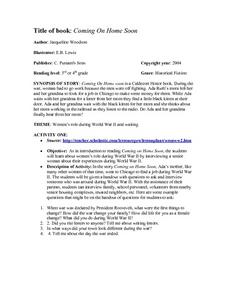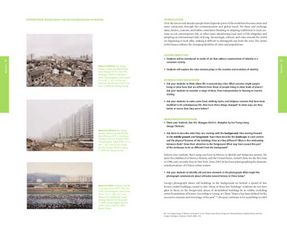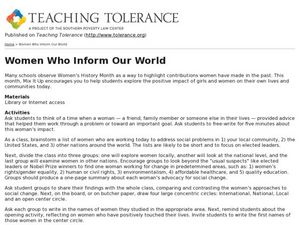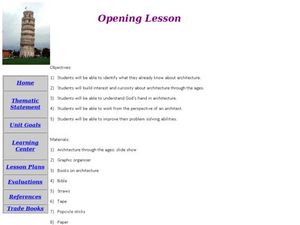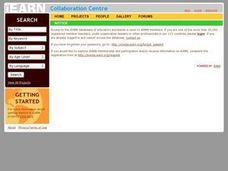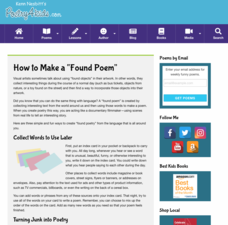Curated OER
Changing the World: Social Entrepreneurs Part Two
Students explore the work of social entrepreneurs. In this entrepreneurship lesson, students research a specific entrepreneur and create a presentation introducing him or her to the class. Students design a seminar on social...
Curated OER
Coming On Home Soon
Learners explore the role of women during World War II. Through a reading of the book "Coming On Home Soon" students gain insight into the ways women helped the war effort. Research and writing activities help support their point of...
Curated OER
Aborigine Dot Turtles
First graders create Aboriginal Dot Turtles using wax colors or crayons. The class discusses Aboriginal stories and art as a way to practice design. This lesson can be done in two 30-minute lesson segments.
Curated OER
Houses and Communities
Students compare homes around the world. For this geography lesson, students compare the different types of houses families live in around the world based on climate, environment and necessity. After listening to stories, students...
Curated OER
Trickster Tales
Students study folk tales and moral lessons from cultures around the world. In this character traits lesson, students study moral lessons through the character traits in various cultures folk tales. Students complete 11 activities...
Curated OER
Globalization and the Standardization of Identity
Students analyze art of changing identities of cities and populations. In this art analysis lesson plan, students analyze the works of art that address constructions of identity in a consumer society. Students explore the role memory...
Curated OER
Women Who Inform Our World
Students examine the contributions of women on the international, national, and local platforms. For this writing skills lesson, students analyze a quote from Eleanor Roosevelt and compose essays that reveal how women advocate for social...
Curated OER
Number The Stars
Students read a book about prejudices that occur in our daily lives. They describe characters in the book. Students discuss real life events of World War II and the Holocaust. Students simulate hiding Jews from the German soldiers. ...
Curated OER
Hey, Mom! What's for Breakfast?
Students examine how he world eats breakfast. In this food choices lesson, students work in groups to list breakfast foods and their ingredients and find goods and consumers on the list. The, students use the Internet to complete a...
Curated OER
Opening Lesson Architecture
Students consider the impact of architecture around the world. In this introductory architecture lesson, students view a sideshow of historic structures and create their own architectural structures using the listed art supplies.
Curated OER
Artists
In this art worksheet, students identify and locate the names of famous artists from around the world. There are 54 names located in the puzzle.
Curated OER
Imaginations & Superstitions
Students examine different superstitions from different countries around the world. They also explore their own imagination to create many more superstitions as a fun activity.
Curated OER
Women Today: An Editorial
Young scholars complete Internet research to write an editorial about a topic relating to the women's rights movement and the issues presently surrounding women's rights in America and around the world.
Curated OER
The Name of the Game
Students explore the cultural significance of various sports from around the world. They then teach their classmates about these sports by participating in a Global SportsFest as both instructors and players.
Curated OER
Secret Stories: Exploring the Elements of Folktales and Fables
Students are introduced to the characteristics of fables and folktales. In groups, they read and identify the various elements in the stories they read from around the world. For each story, they analyze the setting and the various...
Curated OER
The Seasonal Round and The Cycle of Life
Fourth graders are introduced to the concept of the seasonal round and how folklife traditions vary from season to season. They begin charting dates of personal interest on seasonal round calendars by starting with birthdays. Students...
Curated OER
Choral Music 1
In this music worksheet, students listen to choral music from different countries around the world. Students also answer three questions about the music.
Curated OER
Holidays
In this holidays activity, students choose the correct word to complete the sentences about different holidays around the world. Students complete 10 multiple choice questions.
ReadWriteThink
A Picture's Worth a Thousand Words: From Image to Detailed Narrative
A picture's worth a thousand words—and even more inspiration! A visual activity uses photographs to inspire writers. The process teaches aspects of narrative writing, such as point of view and characterization.
Japan Society
The Russo-Japanese War, 1904-1905: A Turning Point in Japanese History, World History, and How War is Conveyed to the Public
The big question: How did Russo-Japanese War imagery and the press influence Japanese perception of the war? Learners consider this big question as they compare and contrast various artistic media from the period. The lesson is...
Poetry4kids
How to Create a “Found Poem”
Writers compose an original found poem by searching for words that inspire them. Words are taken from everyday conversation, books, cut from magazines, the mail, or an already written poem.
Curated OER
World of the Pond
Field trip! The class will review what they know about organisms that dwell in freshwater ponds, then trek down to the old water hole to collect specimens for examination. This includes several web links, useful tips, and an excellent...
California Education Partners
Hope Despair Memory
Elie Wiesel's "Hope, Despair and Memory" provides ninth graders an opportunity to demonstrate their ability to analyze complex text. Individuals craft an essay that draws evidence from the text of the speech to show how Wiesel develops...
NTTI
Transform Your Geometry into a Work of Art
Mathematicians utilize artwork to help illustrate the major ideas of transformations and tessellations. They visually identify transformations including reflections, rotations, and translations. They discuss how artists have used...



